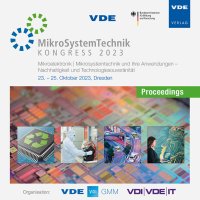Energy dispersive X-ray spectroscopy and spectroscopic ellipsometry for the investigation of ScAlN for applications in microsystems technology
Conference: MikroSystemTechnik Kongress 2023 - Kongress
10/23/2023 - 10/25/2023 at Dresden, Deutschland
Proceedings: MikroSystemTechnik Kongress 2023
Pages: 8Language: englishTyp: PDF
Authors:
Petrich, Rebecca; Slimi, Younes; Krischok, Stefan; Tonisch, Katja (Institute of Physics, IMN MacroNano(R), Technische Universität Ilmenau, Germany)
Honig, Hauke; Steinacker, Lorenz; Schaaf, Peter (Group of Materials for Electrical Engineering and Electronics, IMN MacroNano(R), Technische Universität Ilmenau, Germany)
Barth, Stephan; Bartzsch, Hagen; Gloess, Daniel (Fraunhofer Institute for Organic Electronics, Electron Beam and Plasma Technology FEP, Dresden, Germany)
Kuhnen, Raphael; Fruehauf, Dietmar (Endress+Hauser SE+Co. KG, TTD Technology Development, Maulburg, Germany)
Abstract:
A systematic parameter study and method evaluation to determine the layer properties of ScxAl1-xN thin films is presented. For this purpose, thin films with a concentration range of 0 ≤ x ≤ 0.25 were deposited on 4” Si(111) substrates using pulsed reactive magnetron co-sputtering with a film thickness of δ ≈ 500 nm. Layer thickness and roughness were determined by spectroscopic ellipsometry (SE) and compared to scanning electron microscopy (SEM) and atomic force microscopy (AFM) data. Based on these pre-investigations a quantitative analysis via energy dispersive X-ray spectroscopy (EDX) was performed including an investigation of different parameter conditions like background subtraction, deconvolution and quantification methods as well as quantification references. The choice for the quantification reference appeared to be the most important parameter and the performance of a standard based analysis with ScXAl1-XN thin films or element standards as quantification reference led to the most promising results. Due to the low layer thicknesses, the influence of the excitation conditions and the substrate influence on the results of the analyses was finally investigated.


